The CalREDIE system may be fixed but counties are still anxiously awaiting data uploads so they can plan for safe school and business operations. Santa Clara County jails are experiencing an outbreak and Sonoma County is seeing a notable spike even without complete case data.
The president’s plan to reduce unemployment benefits and charge broke states for 25 percent of the cost is not going over so well here with the governor, and his take on children’s health risks is unsettling as school districts scramble to kick off the year.
Let’s dig in.
U.S.
- Confirmed Cases: 5,089,416
- Deaths: 163,425
Source: John Hopkins University Coronavirus Resource Center COVID-19 global tracking tool as of Monday at 6:34 p.m.

The U.S. Centers for Disease Control and Prevention estimate nationally that about a third of child coronavirus hospital patients require intensive care unit treatment. The CDC also said in a report released Friday that Black children are five times and Latino children eight times more likely than white children to be hospitalized for Covid-19 illness.
The American Academy of Pediatrics and the Children’s Hospital Association reported that more than 380,000 children had tested positive as of Thursday — that data reflects an approximate 90 percent jump in cases in the four-week period between July 9 and Aug. 6.
Though fatality and severe illness rates are very low among infected kids, recent statistics prove they are not immune from contracting the virus and can get very ill.
Children have died in the U.S. and abroad. However, President Donald Trump Monday chose to focus on the low death rates only when pressed on his school reopening stance in light of the spike in cases among children. Asked by a reporter at the White House press briefing if the statistics gave him pause, Trump said:
“There may be a case, a tiny, a tiny fraction of death, tiny fraction, and they get better very quickly.”
Tweet this!
The Georgia high school that became infamous for hallways crowded with unmasked students will temporarily go online after six students and three staffers tested positive COVID-19.
— Kyle Griffin (@kylegriffin1) August 10, 2020
The district said it needs time to disinfect the school. https://t.co/nHK3O3rJAh
Unfortunately, evidence does not support the president’s repeated claims that children are “essentially immune” and that they “don’t get very sick” — when they do become ill enough for hospitalization, they’re admitted to ICU beds at about the same rate as infected adults, the CDC reports. In addition, there are alarming studies identifying long-term effects of the virus after recovery, including but not limited to heart problems, lung damage, neurological issues and sustained respiratory weakness. In short, though death is the worst possible outcome, it is not the only adverse impact.
Still, Trump added Monday:
“I think schools have to open. We want to get our economy going.”
Tweet this!
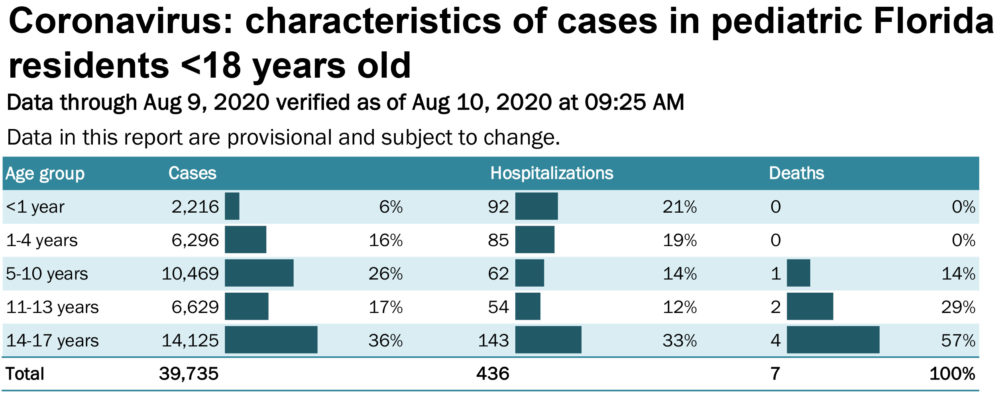
In Florida, which is just about 32,000 cumulative cases behind California, but reflecting a much higher per capita infection rate, 436 children have so far been hospitalized and seven have died due to Covid-19 as of Monday, according to the state’s health department pediatric report.
California
- Confirmed Cases: 569,319
- Deaths: 10,438
Source: John Hopkins University Coronavirus Resource Center COVID-19 global tracking tool as of Monday at 6:34 p.m.
Gov. Gavin Newsom Monday discussed the data reporting issue thought to represent a backlog of about 300,000 positive results not yet properly counted. Technically blaming an outdated system and database failure, the governor added:
“I’m governor. The buck stops with me.”
Tweet this!
He did not elaborate on whether he asked Dr. Sonia Angell, California Department of Public Health director, to resign — Angell abruptly stepped down Sunday. Newsom did say she offered her letter of resignation and he accepted.
The issue with the California Reportable Disease Information Exchange, commonly known as CalREDIE, appears to stem from outdated technology, the governor said. However, he offered little in the way of a detailed explanation.
Dr. Mark Ghaly, the state’s health and human services director, said the problem began July 25 and has resulted in an undercount of between 250,000 and 300,000 test results that were not uploaded to the widely-used system. Some county and city officials, including Los Angeles Mayor Eric Garcetti, have questioned the timing, believing problems may have existed prior to July 25. Ghaly said the issue has been corrected and all backlogged tests have been entered but that it will take a few days for that information to trickle out to counties desperate for a clear picture.
He added that the CalREDIE computing capacity has been increased fourfold in order to prevent future data disruptions.
Also Monday, Newsom pushed back against the unemployment plan Trump announced over the weekend as part of a set of executive orders. Under the Trump administration unemployment benefit extension, if not overturned legally, the additional weekly $600 in Pandemic Unemployment Assistance will be reduced to $400 and will be subject to additional restrictions that may leave many gig workers, freelancers and independent contractors out in the cold.
Additionally, Trump’s plan expects states to pick up 25 percent of the cost, which, like Newsom pointed out, is difficult if not impossible with budgets depleted after months of pandemic response. As opposed to the HEROES Act federal stimulus bill passed by the House that built in funding for struggling states, counties and cities, the Trump unemployment plan would put California out by a minimum of $700 million per week. That’s money the state, which has the highest number of cases, just doesn’t have at this point, Newsom said. CARES Act funding has already been largely allocated.
Newsom said:
“We’re going to need the federal government to provide the support, that 25 percent, or we are at peril of being in a position where we’re making false commitments, false promises to millions of Californians that, ultimately, we simply cannot meet.”
Tweet this!
Trump has balked at and Senate Majority Leader Mitch McConnnell has all but ignored loud and desperate calls for state funding. McConnell already caught heat in April for suggesting states consider bankruptcy. The president often claims Democrat-run states are simply poorly managed and essentially undeserving of a “bailout.” The Senate-forwarded HEALS Act does not provide state funding. Disagreements on state financing are a contributing factor in the federal stimulus standoff.
The California unemployment rate was 14.9 percent in June, according to data released mid-July by the Employment Development Department.
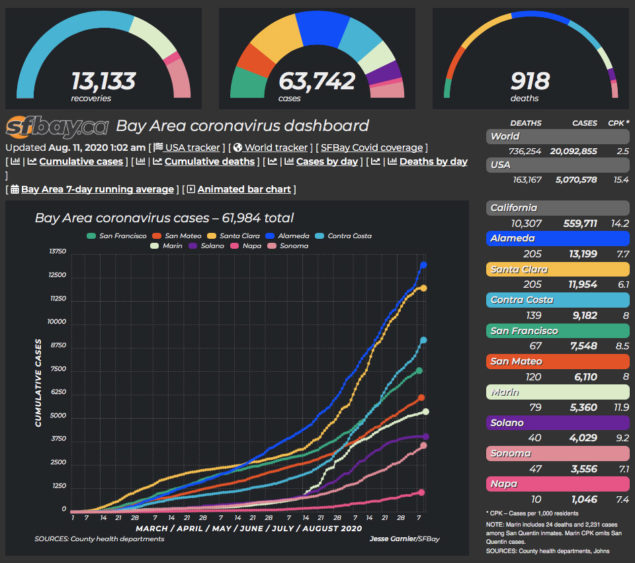
Alameda County
- Confirmed Cases: 13,218
- Deaths: 205
Source: Alameda County Public Health Department as of Monday.
School started Monday for more than 20,000 students in the Oakland Unified School District. Adding to the oddity of going ‘back to school’ in a purely online format, students are also at the mercy of an unsettled agreement over exactly how distance learning should be implemented. The district and the Oakland Education Association were still hammering out details about class sizes, time lengths and expectations from both sides of the negotiation table. A specific focus has been class formats for younger and special education students.
The district and union representatives were set to meet again Monday afternoon in an attempt to finalize a distance learning agreement.
Students were much more prepared Monday than they were when classes were shut down in March due to massive fundraising and philanthropic donations that helped supply needed devices and internet access to kids without. Twitter CEO Jack Dorsey donated $10 million to the effort that enabled students Monday to log in to classes as required. About 25,000 students — half of the district’s total student body — were without internet connection at the beginning of the pandemic.

Alameda County is among those that rely on the state’s CalREDIE system and health officials warn “trends for cases, tests and positivity rates are unstable at this time.” However, the county uses alternative systems to track hospitalizations.
As of Sunday, 169 confirmed Covid-19 patients were hospitalized countywide, 55 of whom in ICU beds. Those numbers are slightly improved from the July 28 peak, when 213 confirmed patients were in hospitals, but are still relatively high.
The soaring cases in Oakland cannot be ignored. The city, even without full CalREDIE accounting, has recorded 5,245 positive test results, with the highest concentration in East Oakland and in the Fruitvale District.
Contra Costa County
- Confirmed Cases: 9,404
- Deaths: 139
Source: Contra Costa Health Services as of Monday at 11:30 a.m.
The CalREDIE data problem is also impacting Contra Costa County in terms of case and testing data, as well as test positivity rates. Despite missing positive test data, the county is still recording alarmingly high new case numbers — 223 new cases were reported Sunday, bringing the seven-day new case average to an all-time high of 194.
The highest case counts are coming out of Richmond, Antioch and Concord, all with more than 1,000 positive test results reported.
The hospitalization rate has remained fairly steady for the past couple weeks — the seven-day hospitalization rate average was 97 patients as of Sunday calculations.
County health officials recently updated the order for mass isolation procedures. The order revised Wednesday requires all people diagnosed with Covid-19 to immediately isolate at home and tell all close contacts that they also need to immediately quarantine for a minimum of 14 days. The isolation and quarantine orders instruct people to stay in their homes, not go to school or work, not to go to the grocery store or run essential errands, not have any visitors and not share drinks or eating utensils.
Detailed guidance for various situations can be found on the county’s website.

There’s a shortage of coins being spent since the pandemic and shelter-in-place orders that forced many people to do their shopping online. Mechanics Bank is inviting people to swap out their spare change for paper currency free of charge in an effort to shore up their coin supply. Danville, Mira Vista and Walnut Creek Mechanics Bank branches will provide the free exchange service Monday through Friday from 10 a.m. to 4 p.m.
Marin County*
- Confirmed Cases: 5,384
- Deaths: 82
Source: Marin Health and Human Services as of Monday. CDCR data as of Monday night.
*Marin County began reporting San Quentin State Prison cases separately, but for the purposes of tracking actual infections and potential impact on the county, we’ve included inmate cases with the county’s cumulative total. Staff member infections and deaths are detailed below but are included in county of residence totals.
Some personal service businesses will be permitted to reopen in outdoor settings, according to a news release issued by Dr. Matthew Willis, the county’s public health officer. Tattoo, piercing and electrolysis services will not yet be permitted, but nail salons, massage therapy, esthetic services, cosmetology and skin care providers did make the list for outdoor operation.
Businesses hoping to take advantage of the reopening strategy are required to complete and implement a Site-Specific Protection Plan. State guidance for outdoor operations can be accessed here.
Marin County also uses the state CalREDIE reporting system.
San Quentin State Prison
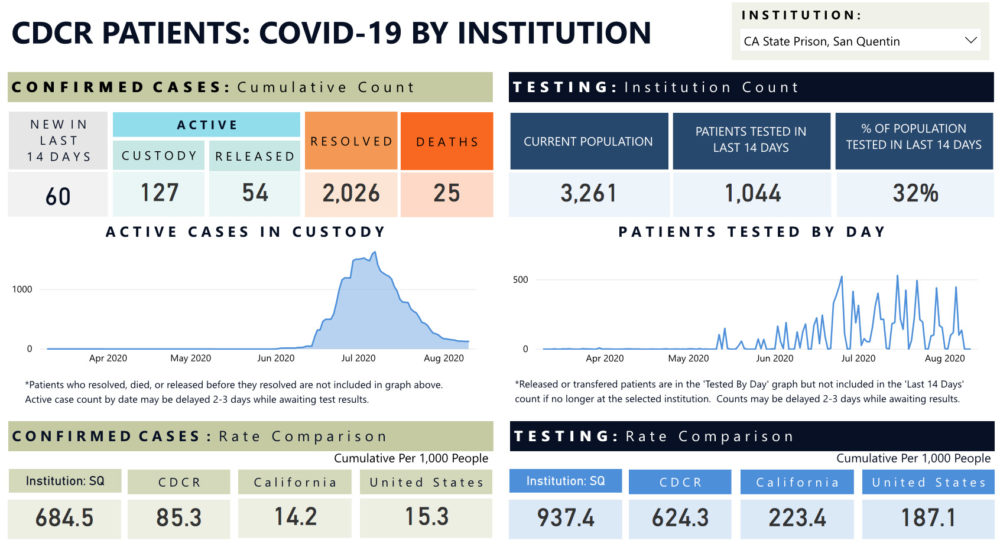
A San Quentin State Prison staff member of 34 years died Sunday from Covid-19. Sgt. Gilbert Polanco, 55, of San Jose developed a cough on Father’s Day and was hospitalized two weeks later. He’d already passed the virus to both his wife and adult daughter. In an interview with Mercury News, his daughter Selena Polanco said:
“He was my best friend. He was my mom’s true love. He was just an amazing man in every way.”
Tweet this!
Twenty-four incarcerated people have also died as a result of the massive virus outbreak at the prison facility. The transfer of infected inmates from a Chino prison in May sparked what Assemblyman Marc Levine called the “worst prison screw-up in state history.”
Since then, more than 2,500 inmates and staff have tested positive, according to the California Department of Corrections and Rehabilitation as of Monday night. The facility’s cumulative infection total is more than double that of the entire Napa County.
Napa County
- Confirmed Cases: 1,074
- Deaths: 11
Source: Department of Health and Human Services as of Monday.
County health officials report that nine people are currently hospitalized for Covid-19 complications. A breakdown of the cases, though also impacted by the CalREDIE reporting problem, shows the City of Napa taking the largest beating from the virus. More than 630 cases have come out of just the one city. Of the positive test results recorded, 137 were among people aged 17 and under, representing nearly 13 percent of the cumulative case count.
San Francisco
- Confirmed Cases: 7,623
- Deaths: 67
Source: San Francisco Department of Public Health with case data as of Friday – information is updated daily but lags by three days.
Though precise case numbers are impossible to gauge until the CalREDIE data is received, a look at the demographic breakdowns paint a picture of a largely Latinx and youth impact. Of those who’ve tested positive, more than half are coming from the Latinx population and 35 percent are among people 30 years old and younger.
Inmates in the San Francisco County Jail system have been unable to visit with family and friends during the pandemic. That unfortunate consequence of the virus is not unique in these times, but city leaders and the San Francisco Sheriff’s Department have set the facilities apart from others in the state with now free phone and video calls.
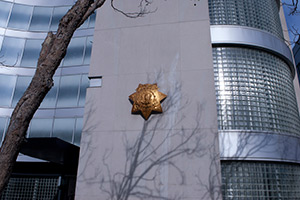
The move to end the practice of profiting off incarcerated people and their families for basic needs has been underway for some time, but a fixed-rate deal worked out with carrier GTL announced Monday makes that idea much more of a reality. Making good on an ordinance passed by the Board of Supervisors in July, inmate phone calls are free as of Monday.
San Mateo County
- Confirmed Cases: 6,318
- Deaths: 120
Source: San Mateo County Health Department with data reported through Sunday.
CalREDIE undercounts are also impacting San Mateo County case totals and testing data.
Hospitalization rates in the county have declined. As of Sunday, there were 26 Covid-19 patients in acute care and 11 receiving ICU treatment.
It’s no secret that local budgets have been hit hard during the pandemic, and federal funding requests in the HEROES Act passed by the House have not come to fruition. As a result, the San Mateo County Superior Court Wednesday has laid off people from 20 positions, mandated 5 percent furloughs for other employees and slashed public hours by 50 percent. According to the SM Daily Journal, court employees represented by the SEIU Local 521 have not accepted the furlough mandate, which would equal work loss of approximately one day per month.
In a press release issued Wednesday, Superior Court Executive Officer Neal Taniguchi said:
“The pandemic emergency left us with little time to plan and absorb the enormous revenue losses occurring statewide. It’s possible that the State may receive bailout funding from the federal government in the fall, but the State imposed our budget reductions effective July 1, which left us with no choice but to act as quickly as possible.”
Tweet this!
Taniguchi warned of additional cuts if the economy does not improve.
The court is expected to resume jury trials Aug. 17 after a courtroom virus exposure prompted temporary shutdown.
Santa Clara County
- Confirmed Cases: 12,694
- Deaths: 205
Source: Santa Clara County Public Health Department as of Tuesday.
Again, “recent data are incomplete” due to the CalREDIE data backlog problem, according to health officials. Hospitalization information, however, is accurate and reflects 177 patients as of Sunday. The health department also reported that 33 percent of the county’s hospital beds remain available, on a seven-day average.
The Mercury News highlighted the county’s largest jail population outbreak to date, citing sheriff’s office data. According to the data, county jails have identified 98 positive test results among inmates since July 20, with 60 of those emerging in the month of August. Since case reporting began in March, there have been 151 positive test results cumulatively, meaning that nearly 40 percent of the cases have been confirmed in just the past 11 days.
The sudden spike is definitely cause for alarm, especially at Elmwood Correctional Complex in Milpitas where 82 inmate infections originate.
Solano County
- Confirmed Cases: 4,274
- Deaths: 41
Source: Solano Public Health as of Monday at 6 p.m.
Solano County, which was just recently experiencing a spike, is showing some relatively positive movement in the right direction. New cases per day and hospitalization rates trending downward. There are currently 30 patients hospitalized countywide, though the health department has noted that state data is not currently available for the number of ICU beds and ventilators available.
Vallejo is reporting 1,445 cases and Fairfield is close behind with 1,374 identified infections.
Sonoma County
- Confirmed Cases: 3,753
- Deaths: 50
Source: County of Sonoma with data as of Monday at 8:45 p.m.
Sonoma County joins most other Bay Area counties as health officials await the data fix from CalREDIE. Until then, positive case and test result data lag behind.
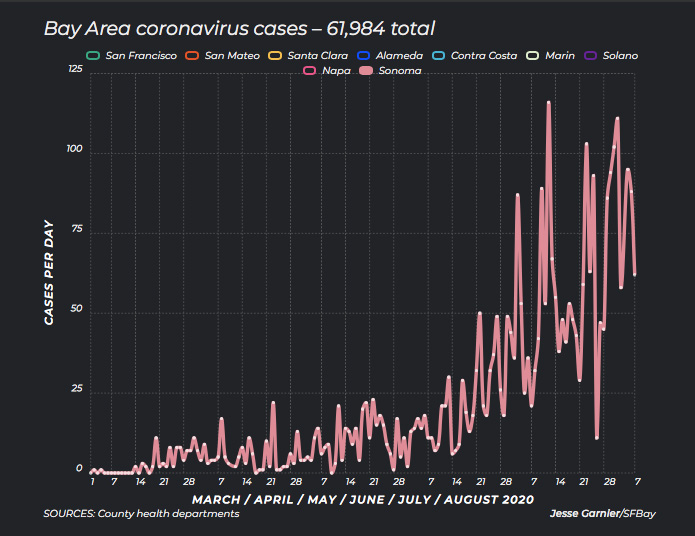
Still, even with the likely undercount, the area is experiencing fairly high rates of new cases each day, with 322 recorded between Saturday and Monday. It would be expected for those daily totals to increase slightly even when data reporting is complete. The trend marks a spike for the area.
The health order enforcement ordinance became effective Thursday. People or businesses violating health orders will now be subject to administrative fines. Citation amounts and further details can be accessed online.
Global
- Confirmed Cases: 20,011,186
- Deaths: 734,664
Source: John Hopkins University Coronavirus Resource Center COVID-19 global tracking tool as of Monday at 6:34 p.m.
Open SFBay Worldwide coronavirus tracker.